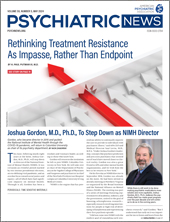In my
editorial in the previous issue of
Psychiatric News, I discussed the risk of socio-cultural factors affecting the integrity of psychedelic clinical trials (PCTs). In light of these substances’ cultural significance, history, and powerful effects (including observable changes in consciousness), rigorous clinical trial design—with randomization, blinding, and control requirements above those typical of nonpsychedelic psychotropic clinical trials—is required. A high level of stringency for psychedelic clinical trials is a necessary safeguard against false positive outcomes that could, in turn, hurt this rapidly expanding area of research.
In this follow-up editorial, I will review some of the major challenges specific to PCTs in the domains of randomization, blinding, and control interventions and propose specific solutions.
Randomization
The challenge: Standard randomized, controlled trials (RCTs) require randomized allocation of study subjects between the different treatment arms. Randomization serves two important functions: (1) to balance known and unknown confounders between groups and (2) to mitigate selection bias. In this second capacity as an anti-bias agent, randomized allocation serves as a proxy for a randomized sampling of the population. While this might be an acceptable proxy for situations in which self-selection of subjects is limited to a target diagnosis, randomized allocation is likely an inadequate proxy for a study in which subjects could self-select based on an a priori preference for the tested intervention, which could be the case with psychedelics. In other words, patients with depression are likely to see all research on antidepressants as equal; thus, they would be equally likely to choose to participate in any of the many antidepressant trials available at a given time. At the same time, a subject without a clinical diagnosis but with an interest in having a psychedelic experience would be more likely to sign up for a PCT than for any other antidepressant randomized, controlled trial.
This problem is compounded by the lack of objective metrics that would convincingly rule in or out a psychiatric diagnosis. Conceivably, anyone can read the DSM-5-TR diagnostic criteria for a given disorder and, with practice, pass a SCID-based diagnostic examination.
The solution: Recruitment should be limited to clinical populations with an objective record supporting the target diagnosis. A history of any substance misuse or psychedelic use should be a standard exclusion criterion. Recruitment advertisement should not include the name of the psychedelic or the class of tested interventions (that is, psychedelics). The subjects for a PCT should be recruited from a pool of potential subjects responding to a generic advertisement about a new research treatment for a specific indication. As small sample sizes are more likely to be biased, a large sample size is desirable.
Blinding
The challenge: Most of the time the standard RCT includes a placebo control arm. Occasionally, an active control arm is included. Standard RCT methodology also includes careful double or triple blinding provisions to ensure that any observed effects are due to the tested intervention. As psychedelics result in rapid and significant changes in consciousness frequently associated with easily observable physiological changes (for example, increased respiratory rate, pupillary dilation), the risk of unblinding both the subject and the researchers is high. If unblinding occurs, the interpretation of observed differences between the study arms is compromised.
The solution: Active controls, with discernable physiological and psychological changes similar to psychedelics, are recommended. Microdosing, or using active compounds at a dose that could result in observable psychological and physical changes that would be unlikely to have therapeutic effects, is an option. Alternatively, psychotropics with immediate physiological and psychological effects either without known therapeutic benefits (for example, yohimbine) or, if with known therapeutic effects (for example, benzodiazepines, stimulants) dosed at subtherapeutic doses could also be considered.
Control
The challenge: Common PCT design combines an active psychedelic intervention with psychotherapy and requires that the study is completed in a comfortable nonclinical setting. Uncontrolled variations in the psychotherapy component and of the therapeutic environment could undermine the validity of a PCT’s results.
The solution: A factorial study design is standard for studies using combination interventions with the goal of testing only one of the combination factors. For PCTs in which psychedelics are combined with psychotherapy, adding two additional control arms is necessary to differentiate the specific effects of the active psychedelic: an arm in which an active control is combined with active psychotherapy, and an arm in which the active intervention is combined with inactive/placebo psychotherapy.
To summarize, as the field of psychedelic research is advancing, it is clear that PCTs require more stringent standards of design and execution compared with traditional psychotropic RCTs. In this editorial, I have reviewed some of the important challenges associated with the randomization, blinding, and control of PCTs and briefly discussed specific solutions to increase the validity and safety of PCTs.
There is so much more to be done, however. The time has come for all invested parties (researchers, regulatory agencies/FDA, and research sponsoring agencies) to work together and develop a clear set of standards for PCTs. ■

